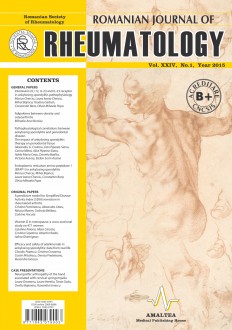SELECT ISSUE

Indexed

| |

|
|
|
| |
|
|
|

|
|
|
|
|
|
| |
|
|
HIGHLIGHTS
National Awards “Science and Research”
NEW! RJR has announced the annually National Award for "Science and Research" for the best scientific articles published throughout the year in the official journal.
Read the Recommendations for the Conduct, Reporting, Editing, and Publication of Scholarly work in Medical Journals.
The published medical research literature is a global public good. Medical journal editors have a social responsibility to promote global health by publishing, whenever possible, research that furthers health worldwide.
VITAMIN D IN MENOPAUSE: A CROSS-SECTIONAL STUDY ON 471 WOMEN
Catalina Poiana, Mara Carsote, Cristina Capatina, Valentin Radoi and Adina Ghemigean
ABSTRACT
Introduction. Vitamin D is intensively studied during the last years. The most useful instrument to assess the vitamin D status is serum 25-hydroxy vitamin D (25-OH D).
Material and method. This is a cross sectional study in menopausal women, between 2008 and 2013 with inclusion criteria: at least 1 year since menopause, age between 40 and 80 years; exclusion criteria: specific therapy for osteoporosis, previous diagnosis of osteomalacia and rickets, primary hyperparathyroidism.
Results. 471 subjects were: group 1 with osteopenia and osteoporosis (N = 328) and group 2 with normal DXA (N = 143) which were statistically significant (SS) different regarding the age, body mass index (BMI), years since menopause, bone markers osteocalcin and CrossLaps, with no SS differences between 25-OH D. In group 1: the linear regression coefficient (r) between alkaline phosphatase and 25-OH D was -0.14 (p = 0.01). In group 2: the BMI distribution showed: normal weighted subjects (BMI ≤ 24.9 kg/m2 , N = 22, 15%, av. 25-OH D = 19.69 ng/mL), overweighed females (BMI = 25-29.9 kg/m2 , N = 56, 39%, av. 25-OH D = 15.11 ng/mL ), obese (BMI ≥ 30 kg/m2 , N = 65, 46%, av. 25-OH D = 12.11 ng/mL), with SS differences between any 2 subgroups. 25-OH D is not SS different between the subgroups based on decades of years since menopause, regardless the DXA score.
Conclusion. Based on our observations, a prevalent low level of vitamin D is registered in menopausal women regardless they have or not osteoporosis and in women with normal DXA the vitamin D level is lower in obsesses versus normal or overweighed patients.
Keywords: vitamin D, menopause, osteopenia, osteoporosis
